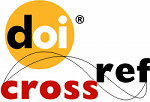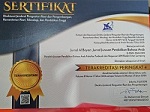Mind Mapping: Reading Comprehension Technique of Arabic Texts for Students in Higher Education
Abstract
Keywords
Full Text:
PDFReferences
Astriani, Dyah, Herawati Susilo, Hadi Suwono, Betty Lukiati, and Aris Rudi Purnomo. "Mind Mapping in Learning Models: A Tool to Improve Student Metacognitive Skills." International Journal of Emerging Technologies in Learning 15, no. 6 (2020): 4-17. https://doi.org/10.3991/IJET.V15I06.12657.
Aziz, Azura Binti Abdul, and Hamidah Bt Yamat. “The Use of Mind Mapping Technique in Increasing Students’ Vocabulary List.” Journal of Education and Social Sciences, 2016.
Bukhari, Syeda Saima Ferheen. “Mind Mapping Techniques to Enhance EFL Writing Skill.” International Journal of Linguistics and Communication 4, no. 1 (2016): 58-77. https://doi.org/10.15640/ijlc.v4n1a7.
Buran, Anna, and Andrey Filyukov. “Mind Mapping Technique in Language Learning.” Procedia - Social and Behavioral Sciences 206, (2015): 215-218. https://doi.org/10.1016/j.sbspro.2015.10.010.
Karuppan, Corinne M., Nancy E. Dunlap, and Michael R. Waldrum. Operations Management in Healthcare: Strategy and Practice. Alabama: UAB Health System, 2022.
Buzan, Tony. Mind Map Mastery: The Complete Guide to Learning and Using the Most Powerful Thinking Tool in the Universe. Watkins Media Limited, 2018.
Buzan, Tony. “The Buzan Study Skill Handbook : The Shortcut to Success in Your Studies with Mind Mapping, Speed Reading and Winning Memory Techniques.” In BBC Active, 2007.
Swann, Ken. "Entrepreneurship in Large Companies.” Journal of General Management 2, no. 4 (1975): 48-54.
Čoban, Sibel, and Ekin Selçuk Tokatli. “The Effect of Mind Mapping Technique on Students’ Achievements in Music Lesson and on Their Attitudes towards the Mind Mapping Technique.” Education and Science 42, no. 190 (2017): 423-435. https://doi.org/10.15390/EB.2017.6856.
Delatu, Tara A., Diane Wowor, and Sarah Kamagi. “Increasing Students’ Vocabulary by Using Mind Mapping Technique at SMP N 2 Bitung.” Journal of English Culture, Language, Literature and Education 8, no. 2 (2021): 88-96. https://doi.org/10.53682/eclue.v8i2.1621.
Dewi, Ratna Sari, Fahrurrozi, Uswatun Hasanah, and Apri Wahyudi. “Reading Interest and Reading Comprehension.” Talent Development & Excellence 12, no. 1 (2020): 241-250.
Dirix, Nicolas, Heleen Vander Beken, Ellen De Bruyne, Marc Brysbaert, and Wouter Duyck. “Reading Text When Studying in a Second Language: An Eye-Tracking Study.” Reading Research Quarterly 55, no. 3 (2020): 1-63. https://doi.org/10.1002/rrq.277.
Donoghue, Gregory M., and John A.C. Hattie. “A Meta-Analysis of Ten Learning Techniques.” Frontiers in Education, 2021. https://doi.org/10.3389/feduc.2021.581216.
Elleman, Amy M., and Eric L. Oslund. “Reading Comprehension Research: Implications for Practice and Policy.” Policy Insights from the Behavioral and Brain Sciences 6, no. 1 (2019): 3-11. https://doi.org/10.1177/2372732218816339.
Moore, B. "Social origins of Dictatorship and Democracy: Lord and Peasent in the Making of the Modern World." Beacon Press 268, (1993).
Nevo, G. A., and Manassis K. "Outcomes for Trated Anxious Children: a Critical Review of Long-Term-Follow-Up Studies." Depression and Anxiety 26, no. 7 (2009): 650-660.
Hazaymeh, Wafa’ A., and Moath Khalaf Alomery. “The Effectiveness of Visual Mind Mapping Strategy for Improving English Language Learners’ Critical Thinking Skills and Reading Ability.” European Journal of Educational Research 11, no. 1 (2022): 141-150. https://doi.org/10.12973/eu-jer.11.1.141.
Hernacki, Mike, Bobbi Deporter, Awiyah Abdurrahman, Sari. Meutia, Sari Meutia, translator Alwiyah Abdurrahman, Alwiyah Abdurrahman, Alwiyah Abdurrahman, and translator Sari Mutiah. “Quantum Learning : Membiasakan Belajar Nyaman Dan Menyenangkan.” (2006).
Husni, Muhamad, and Zainuddin. “Memahami Konsep Pemikiran Mind Map Tony Buzan (1970) dalam Realitas Kehidupan Belajar Anak.” Al-Ibrah 3, no. 1 (2018): 110-126.
Karim, Rafidah Abd. “Technology-Assisted Mind Mapping Technique in Writing Classrooms: An Innovative Approach.” International Journal of Academic Research in Business and Social Sciences 8, no. 4 (2018): 1092-1103. https://doi.org/10.6007/ijarbss/v8-i4/4146.
Liu, Ting, and Takaya Yuizono. “Mind Mapping Training’s Effects on Reading Ability: Detection Based on Eye Tracking Sensors.” Sensors 20, no. 4422 (2020): 1-15. https://doi.org/10.3390/s20164422.
Margunayasa, I Gede, Ni Nyoman Kusmariyatni, Ni Luh Sri Surya Wisma Jayanti, Ni Made Daini Vitra Sinta Sari, and I Made Hendra Sukmayasa. “The Effect of Collaborative Learning Aided by Mind Mapping Method on Science Learning Achievement.” ICTES, (2019): 1-6. https://doi.org/10.4108/eai.21-11-2018.2282049.
Munasti, Kholida, Hibana Hibana, and Susilo Surahman. “Penggunaan Mind Mapping sebagai Media Pengembangan Kreativitas Anak di Masa Pandemi.” Aulad: Journal on Early Childhood 4, no. 3 (2021): 179-185. https://doi.org/10.31004/aulad.v4i3.104.
Naghmeh-Abbaspour, Bita, and Vahideh Rastgoo. “Analysis for Finding the Effect of Mind Mapping Technique on the Iranian English as Foreign Language Learning’ Writing Skills.” Texto Livre: inguagem & Tecnologia 13, no. 2 (2020): 102-116. https://doi.org/10.35699/1983-3652.2020.24559.
Novak, Joseph D., and Alberto J. Cañas. “The Origins of the Concept Mapping Tool and the Continuing Evolution of the Tool.” Information Visualization 5, no. 3 (2006): 175-184. https://doi.org/10.1057/palgrave.ivs.9500126.
Orlova, Nataliia. “Efficiency Of Mind Mapping For The Development Of Speaking Skills In Students Of Non-Linguistic Study Fields.” Science and Education, no. 6 (2017): 151-161. https://doi.org/10.24195/2414-4665-2017-6-23.
Papushina, Iuliia, Olga Maksimenkova, and Andrei Kolomiets. “Digital Educational Mind Maps: A Computer Supported Collaborative Learning Practice on Marketing Master Program.” In International Conference on Interactive Collaboration Learning 544, (2017). https://doi.org/10.1007/978-3-319-50337-0_2.
Pardo-Tolentino, Carolyn F., and Rischelle G. Aggabao. “Collaborative Instructional Strategies and Attitudes toward Second Language Learning.” International Journal of Linguistics, Literature and Translation 3, no. 5 (2020): 60-67. https://doi.org/10.32996/ijllt.2020.3.5.7.
Polat, Özgül, Türker Sezer, and Nevra Atış-Akyol. “Collaborative Learning with Mind Mapping in the Development of Social Skills of Children.” Participatory Educational Research 9, no. 1 (2022): 463-480. https://doi.org/10.17275/per.22.25.9.1.
Purwanto, M. Bambang, and Marsinah. “The Use of Mind Mapping Technique to Improve the EFL Students’ Reading Comprehension Ability of Darussalam Polytechnic.” Esteem Journal of English Education Study Programme 4, no. 2 (2021): 52-62. https://doi.org/10.31851/esteem.v4i2.5136.
Ridder, Hans Gerd, Matthew B. Miles, A. Michael Huberman, and Johnny Saldaña. “Qualitative Data Analysis. A Methods Sourcebook.” Zeitschrift Fur Personalforschung 28, no. 4 (2014): 487-487.
Roller, Margaret R. “A Quality Approach to Qualitative Content Analysis: Similarities and Differences Compared to Other Qualitative Methods.” Forum Qualitative Sozialforschung 20, no. 3 (2019). https://doi.org/10.17169/fqs-20.3.3385.
Rufaida, Kanza, and Muassomah. “Model Pembelajaran Flipped Classroom dalam Pembelajaran Ketrampilan Membaca di MTS Al-Hikmah Brebes.” Tarling : Journal of Language Education 5, no. 1 (2021): 93-108. https://doi.org/10.24090/tarling.v5i1.4369.
Sam, Zulfiah. “Metode Pembelajaran Bahasa Arab.” Nukhbatul ’Ulum: Jurnal Bidang Kajian islam 2, no. 1 (2016): 206-220. https://doi.org/10.36701/nukhbah.v2i1.16.
Sidik, Anwar, and Muassomah. “Implementasi Metode Mind Mapping dengan Menggunakan Media Power Point dalam Pembelajaran Nahwu.” Alsina: Journal of Arabic Studies 3, no. 2 (2021): 241-260. 10.21580/alsina.3.2.6734.
Abubakar, Sitti Rahmaniar, Aprillianti, Ahid Hidayat, Muamal Gadafi, and Nanang Sahriana. “Using Mind Mapping Learning Methods for Children’s Language Skills.” Jurnal Pendidikan Usia Dini 15, no. 1 (2021). https://doi.org/10.21009/jpud.151.08.
Snow, Pamela C. “SOLAR: The Science of Language and Reading.” Child Language Teaching and Therapy 37, no. 3 (2021): 222-233. https://doi.org/10.1177/0265659020947817.
Tee, T K, M N A Azman, S Mohamed, M M Mohamad, J Yunos, M H Yee, and W Othman. “Buzan Mind Mapping : An Efficient Technique For.” International Journal of Social, Behavioral, Educational, Economic, Business and Industrial Engineering 8, no. 1 (2014): 28-31.
Wahyudi, Wahyudi, and Rika Irawati. “Mind Mapping Technique in Developing Students’ Speaking Skill.” Eksos 17, no. 2 (2019): 77-84. https://doi.org/10.31573/eksos.v15i2.84.
Wibowo, Furqon Edi. “Mind Mapping : A Strategy to Enhance Students’ English Grammatical Structure.” Al-Lisan: Jurnal Bahasa 5, no. 2 (2020): 213-229. https://doi.org/10.30603/al.v6i2.1321.
Widyahening, Christiana Evy Tri. “Penggunaan Teknik Pembelajaran Fishbone Diagram dalam Meningkatkan Keterampilan Membaca Siswa.” Jurnal Komunikasi Pendidikan 2, no. 1 (2018): 11-19.
Wong, Alvin, Daisy Kunang Anak Kuah Jebi, Yii Hung Ying, and Melor Md Yunus. “Collaborative Writing Strategy: CollaboWrite with MindMeister.” International Journal of Academic Research in Business and Social Sciences 9, no. 2 (2019): 146-158. https://doi.org/10.6007/ijarbss/v9-i2/5530.
Yunus, Melor Md, and Chan Hua Chien. “The Use of Mind Mapping Strategy in Malaysian University English Test (MUET) Writing.” Creative Education 7, no. 4 (2016). https://doi.org/10.4236/ce.2016.74064.
DOI: http://dx.doi.org/10.24042/albayan.v14i2.14350
Refbacks
- There are currently no refbacks.
Copyright (c) 2022 Jurnal Al Bayan: Jurnal Jurusan Pendidikan Bahasa Arab
License URL: https://creativecommons.org/licenses/by-nc-sa/4.0
Editorial Office:
Jurnal Al Bayan: Jurnal Jurusan Pendidikan Bahasa Arab, Arabic Education Study Program, Faculty of Education and Teachers Training, Unversitas Islam Negeri Raden Intan Lampung
Jl. Endro Suratmin 1 Sukarame, Bandar Lampung 35131-Indonesia
e-mail: jurnalalbayan@radenintan.ac.id
http://ejournal.radenintan.ac.id/index.php/albayan/index
Jurnal Al Bayan: Jurnal Jurusan Pendidikan Bahasa Arab is licensed under a Creative Commons Attribution-ShareAlike 4.0 International License. p-ISSN 2086-9282 | e-ISSN 2549-1229









